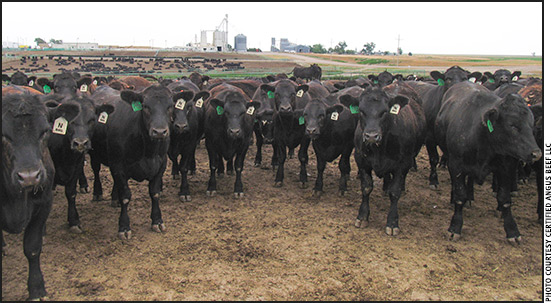
Uniform Cattle Increase Profit Potential
John Simons ranches with his family near Enning, S.D., where they’ve focused on reducing variability in their Angus-based cow herd for the last 20 years.
“If your calves all look the same, they’re just a pretty package,” he says. “Pretty sells.”
Sticking with one breed and bloodline for several years lets Simons produce calves that have the same phenotype and perform similarly in the feedlot and on the rail.
“They might not all be brothers, but they’ll be related,” he says, noting the family only switches bulls when they start retaining heifers and need to infuse a divergent bloodline.
Sale-barn studies routinely prove uniformity in weight and cattle type mean premiums at auction, but the rancher really noticed the difference when Simons began working closely with Haverhals Feedlot near Hudson, S.D., a decade ago. Simons has retained partial ownership on steer and heifer calves ever since.
“This has been an eye-opening experience for me,” he says.
A recent analysis spanning nine years and 67,000 calves fed in the Iowa Tri-County Steer Carcass Futurity shows finished cattle in the same pen differ in average value by nearly $700 from top to bottom.
“Variations within a feedlot pen make management and marketing a great challenge, especially when selling on a carcass-merit basis,” says the technical bulletin published by Certified Angus Beef LLC (CAB).
In the study, receiving weight varied by 401 pounds (lb.), and the gap in finished weight widened to 546 lb.
“The more uniform a group, the more likely that a feeder will pass some premium back to the producer,” says Kelly Bruns, South Dakota State University animal scientist. “It saves them time and pen space, because they may not have to sort these groups.”
Breaking the data into the most uniform quarter compared to least shows a much tighter set of cattle. The top group sold within a 25-day window and had a 388-lb. average difference in finished weight. That’s compared to the most variable 25%, which sold during a 56-day period and had a 750-lb. average span in harvest weight.
Cattle with similar performance potential allow feeders to make blanket decisions about feeding and implant strategies, Bruns says.
“As they try to capture value on a carcass-based pricing system, being more uniform is certainly a benefit,” he says.
As feeders try to hit a “sweet spot” on many grids, the fewer outliers, the better.
The carcass-value disparity in the least variable quarter was $148 per head, compared to the most variable, which had an average carcass-value variation of $329 per head.
Bruns says the two easiest ways to create a more like set of calves are related to age and genetics.
“If we can keep the calving window tight, it’s huge,” he says. Technology like synchronized artificial insemination (AI) can help, but anybody can cull cows that are continually late calvers.
Good herd management helps narrow that window, too.
“Proper nutrition and management in the months before [a rancher] decided to turn out bulls becomes pretty important, so that they’ll settle in their first heat,” Bruns says.
After that, it’s about selecting like sires.
“If they have the ability to choose bulls with similar parentage or at least similar genetic potential, it helps,” he says.
That’s been the key to Simons’ successful transition.
“I was so poor when I started, I couldn’t afford to pay attention to what kind of bulls I had,” he laughs. Now they invest at least five years of careful study in the next bloodline they want to use, and always look to buy the top bulls they can afford.
“Once we started buying the good ones, we had to continue to do it,” he says. “Because if we didn’t, we weren’t improving.”
Simons gained herd consistency as an unintentional secondary benefit.
“I want the calves to be uniform, because that’s what I sell, but my cows have been more uniform and more predictable,” he says.
Plus, it has reduced on-ranch labor.
“When one is ready to go, they’re all ready to go,” he says. So there’s little sorting, and the next segment is happy with his calf crop.
“If they like one, they like them all,” he says.
For more information, or to access “The Cost of Variability” Black Ink Basics Technical Bulletin, visit www.cabpartners.com/educators.
Editor’s Note: This article was provided by Certified Angus Beef LLC.






